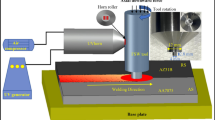Abstract
The purpose of this study is to investigate mechanical and microstructure properties of AISI 2205 and AISI 1020 steel couples joined by using friction welding method and having different chemical compositions. Therefore, macroscopic examinations of specimens joined by using different welding parameters were performed and their mechanical properties were determined by using tension and fatigue tests. Effects of welding parameters on joint interfaces were completed by microhardness measurements and SEM analysis. Consequently, it was determined that mechanical and microstructure properties of AISI 2205 and AISI 1020 steel couples changed based on welding parameters and the quality of the joint could be enhanced in case that parameters compatible with each other were selected.

















Similar content being viewed by others
References
Dinc D (2006) Investigation of weldability of AISI 1040 and AISI 304 steels by friction welding, M.Sc. Thesis, Balıkesir Üniversty, Institute of Science, Balıkesir, Turkey
Mercan S (2013) The investigation of microstructure and fatigue behavior of friction welded AISI 2205/AISI 1020 steel couple. PhD. Tehsis, Fırat Üniversity, Institute of Science, Elazığ, Turkey
Özdemir N (2002) Investigation of weldability of fine-grained low alloyed high carbon steels by friction welding. PhD. Tehsis, Fırat Üniversity, Institute of Science, Elazığ, Turkey
Anık S (1991) Gedik Education Foundation technical resource manual methods and equipment. İstanbul, Turkey
Lee DG, Jang KC, Kuk JM, Kim IS (2004) Fatigue properties of inertia dissimilar friction-welded stainless steels. J Mater Process Technol 155–156:1402–1407
Yan JH, Zheng K, Zhao K (2000) Prediction of fatigue life and its probability distribution of notched friction welded joints under variable-amplitude loading. Int J Fatigue 22(6):481–494
Ajith PM, Barik BK, Sathiya P, Arvindan S (2015) Multiobjective optimization of friction welding of UNS S32205 duplex stainless steel. Defence Technology 11:157–165
Mercan S, Aydin S, Ozdemir N (2015) Effect of welding parameters on the fatigue properties of dissimilar AISI 2205–AISI 1020 joined by friction welding. Int J Fatigue 81:78–90
Ochi H, Yamamoto Y, Ogawa K, Tsujino R, Sawai T, Suga Y (2003) Evaluation of tensile strength and fatigue strength of SUS304 stainless steel friction welded joints. The International Society of Offshore and Polar Engineers Conference 1098–6189
Paventhan R, Lakshminarayanan PR, Balasubramanian V (2011) Fatigue behaviour of friction welded medium carbon steel and austenitic stainless steel dissimilar joints. Mater Des 32:1888–1894
Şahin M, Akata EH, Gülmez T (2007) Characterization of mechanical properties in AISI 1040 parts welded by friction welding. Mater Charact 58:1033–1038
Çalıgülü U, Orhan A, Gür AK (2007) Effect of rotational speed on the microstructure of friction welded AISI 420/AISI 1010 steels. Science and Eng J of Fırat University 19(4):583–592
Westgate SA, Dunkerton SB (1985) Friction and flash welding-mechanical properties reviewed. The Welding Int Research Bul:49–53
Yılmaz M (1993) The investigation of weld region of friction welded different tool steels. PhD. Tehsis, Yıldız Teknik Üniversity, Institute of Science, İstanbul, Turkey
Çelik S, Ersözlü İ (2009) Investigation of the mechanical properties and microstructure of friction welded joints between AISI 4140 and AISI 1050 steels. Mater Des 30:970–976
Aran A, Demirkol M (1995) Plastic forming and technology, ITU Faculty of Mechanical Engineering Manufacturing Processes Lecture Notes, İstanbul, Turkey
Ünal E (2003) The investigation of fatigue strength of stainless steels to AISI 4340 steel welded by friction welding. M.Sc. Thesis, Firat Üniversty, Institute of Science, Elazığ, Turkey
Şahin M (2009) Characterization of properties in plastically deformed austenitic-stainless steels joined by friction welding. Mater Des 30:135–144
Nascimento MP, Voorwald HJC (2010) Considerations on corrosion and weld repair effects on the fatigue strength of a steel structure critical to the flight-safety. Int J Fatigue 32:1200–1209
Acknowledgements
The University of Fırat, Institute of Science, Department of Technical Education, contributed to this study. Authors render thanks to all of these institutions (project no.: FÜBAP TEF 1002)
Author information
Authors and Affiliations
Corresponding author
Additional information
Recommended for publication by Commission III - Resistance Welding, Solid State Welding, and Allied Joining Process
Rights and permissions
About this article
Cite this article
Mercan, S., Özdemir, N. Weldability characteristics of friction-welded AISI 2205 to AISI 1020 steels. Weld World 61, 667–677 (2017). https://doi.org/10.1007/s40194-017-0441-1
Received:
Accepted:
Published:
Issue Date:
DOI: https://doi.org/10.1007/s40194-017-0441-1




